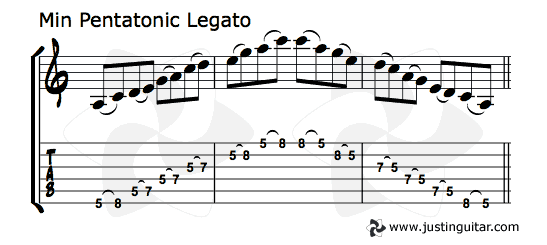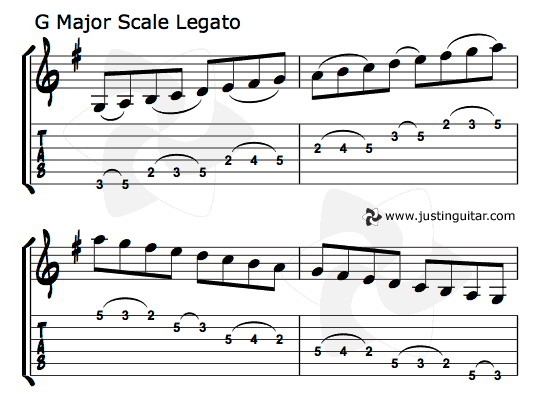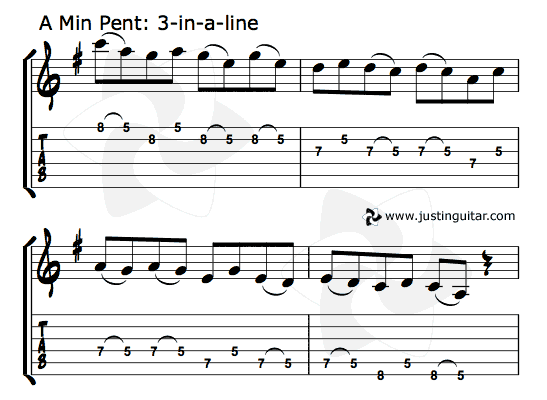JustinGuitar.com uses cookies to enhance your browsing experience. By continuing to use this site, you consent to the use of cookies. For more detailed information, please review the full Terms & Conditions.
📖 Food For Thought by Justin Sandercoe is here—transform your musical mindset and elevate your guitar journey! Get your copy now; stock is limited!
Legato means smoothly, and with less picking the sound is smoother. The technique we are checking out today is using hammer on's and flick off's to play your scales. Makes your fingers stronger and scales faster. Excellent!
If you have not had much experience using hammer on and flick off's before the first step is to play around with it. Start on the thinnest string, first finger 5th fret, pick the note and then hammer down your 2nd finger real hard without picking it. Do it right and the note should be almost as loud as the picked one.
After a few goes try the same thing with your 3rd and then your 4th finger. Pick the note played by your first finger then hammer down the next note.
Once you feel cool with that you should try the "flick off". Just so you are aware, most books and other people call it a "pull off' but I think it's a dumb term, because what you do is flick it off, so I'm going to call it that.
Put your first finger down where it was before and leave it down and put down your 3rd finger. Pick the note held by your 3rd finger and flick it off (toward the ground) so the note held by the 1st finger sounds!
Once you get it, try it with the other fingers. Then go onto applying them to scales.
The scale is very often played with legato. It's lots of fun and will help you out with lots of licks! Unusually you will play the top note twice in this sequence (that is usually avoided when playing scales, but works better in this!)

Playing the major scale legato require a better level of the technique because you most often have 3 notes on each string and so have to make two hammer on's or flick offs in a row - but that is good! Great practice :)

You will also find that Legato technique will help you play your melodic patterns in the minor pentatonic scale a lot smoother and faster. Many of the fast rock and blues licks that use melodic patterns also use Legato. Notice sometimes you will do two flick off's in a row when you might think it better to do a hammer on... we do it this way to make sure you will pick the note on the first of each group of 3... Try this one for fun:

Why don't you try using the Legato technique on some of the other melodic patterns that you have learnt??
You could always try using legato with the major scale melodic patterns too!! Hint hint ;)
After you have been doing this a while you might like to check out my lesson on an exercise called The Finger Gym which uses these techniques. It's pretty full on but I've seen it transform people's playing! So after you have finished the Intermediate Foundation you might want to get into that!
The finger gym is an awesome exercise and is one that if you do it 5 min a day you will notice a big improvement in your hand strength, dexterity and independence. You don't have to start doing it right now, in fact just making a start by playing these scales using the legato technique is probably a good idea. But I would highly recommend that you start doing the finger gym as part of your regular practice routine as soon as you finish the intermediate foundation lessons.
Okay now it is time to look at some more advanced rhythm guitar techniques. :)

Food For Thought by Justin Sandercoe is an inspiring collection of short, insightful articles that delve into mindset, motivation, and personal growth tailored specifically for guitarists and musicians. Originally featured in Guitar Techniques magazine, these articles take you beyond technical skills to explore the psychological and emotional journey of playing music. Discover how to overcome frustration, build confidence, stay motivated through challenges, find genuine joy in your playing, and deepen your understanding of music itself. Grab your copy today and unlock a whole new dimension to your musical journey!